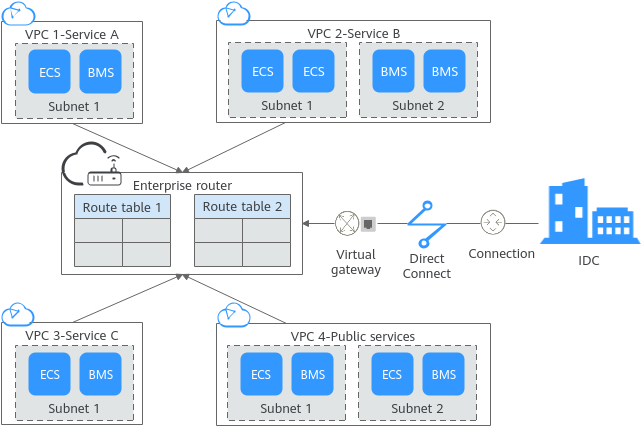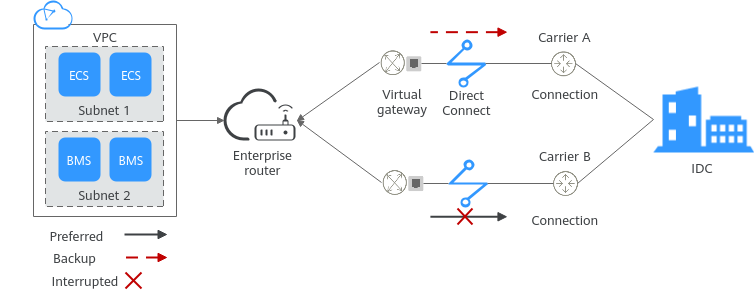When to Use Enterprise Routers¶
You can use enterprise routers to build cloud, on-premises, or hybrid networks. Here are some typical application scenarios:
Scenario 2: Dynamic switchover between Direct Connect connections
Scenario 3: Active/Standby Direct Connect and VPN connections
Scenario 1: Multiple VPCs communicating or not communicating with each other on the cloud, but communicating with the on-premises data center through a Direct Connect connection¶

Figure 1 Diagram for scenario 1¶
Customer Requirements | Multiple service networks communicate or do not communicate with each other on the cloud but communicate with the on-premises data center. Suppose you require three VPCs for running the workloads on the public cloud, and the three VPCs (services A, B, and C) need to access public services in VPC 4 and your on-premises data center. |
Pain Points |
|
Benefits of Using Enterprise Routers |
|
Scenario 2: Dynamic switchover between Direct Connect connections¶

Figure 2 Diagram for scenario 2¶
Customer Requirements | Some services run on the public cloud and some in the on-premises data center. Two independent high-bandwidth Direct Connect connections are deployed between the public cloud and the data center to enable communication between them. |
Pain Points | Two Direct Connect connections are independent of each other and cannot work in load-sharing or active/standby mode. |
Benefits of Using Enterprise Routers | Direct Connect connections are connected to the enterprise router.
|
Scenario 3: Active/Standby Direct Connect and VPN connections¶

Figure 3 Diagram for scenario 3¶
Customer Requirements | You are running workloads in your on-premises data center and on the public cloud. A single Direct Connect connection connects your on-premises data center to the cloud, which cannot ensure reliability. |
Pain Points | You cannot afford another Direct Connect connection. |
Benefits of Using Enterprise Routers | In this example, there are two connections, one Direct Connect connection and a VPN connection. Enterprise Router, Direct Connect, and VPC are used to build a hybrid cloud. When the Direct Connect connection becomes faulty, the VPN connection takes over to ensure that connectivity is not interrupted. |